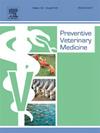Evaluation of SARS-CoV-2 antibody detection methods for wild Cervidae
IF 2.4
2区 农林科学
Q1 VETERINARY SCIENCES
引用次数: 0
Abstract
Wildlife surveillance programs often use serological data to monitor exposure to pathogens. Diagnostic sensitivity and specificity of a serological assay quantify the true positive and negative rates of the diagnostic assay, respectively. However, an assay’s accuracy can be affected by wild animals’ pathogen exposure history and quality of the sample collected, requiring separate estimates of an assay’s detection ability for wild-sampled animals where an animal’s true disease status is unknown (referred to hereafter as sampling sensitivity and specificity). We assessed the sampling sensitivity and specificity of a Severe Acute Respiratory Syndrome Coronavirus 2 (SARS-CoV-2) surrogate virus neutralization test (sVNT) and conventional virus neutralization tests (cVNT) to detect antibodies for ancestral and Omicron B.1.1.529 variants of SARS-CoV-2 in wild white-tailed deer (Odocoileus virginianus) and mule deer (Odocoileus hemionus). We studied the influence of sample collection method using paired blood samples collected in serum separator tubes and on Nobuto strips from the same animal. Mean estimates of sampling sensitivity and specificity ranged from 0.21–0.95 and 0.94–1.00, respectively, varying by sample collection method, host species, and SARS-CoV-2 variant targeted by the assay. Broadly, sampling sensitivity was estimated to be higher for 1) sera collected in tubes, 2) detecting pre-Omicron SARS-CoV-2 variants, and 3) sVNT relative to cVNT assays. Sampling specificity tended to be high for all tests. We augmented our study with SARS-CoV-2 spike protein sequences derived from sampling locations and times coincident with white-tailed deer captures, finding common amino acid mutations relative to the sVNT Omicron antigen variant. The mutations may indicate that the SARS-CoV-2 variants circulating in cervids from 2021 through 2024 may be better adapted to cervid hosts and more closely related to variants that circulated in humans prior to Omicron variants. We conclude our study with an inter-test comparison of sVNT results, revealing that 40 % inhibition is an optimal threshold for test positivity when testing deer sera for responses to Omicron variant B.1.1.529, compared to the 30 % inhibition recommended for ancestral variants.
野生鹿科动物SARS-CoV-2抗体检测方法评价
野生动物监测项目经常使用血清学数据来监测病原体的暴露情况。血清学分析的诊断敏感性和特异性分别量化了诊断分析的真阳性率和阴性率。然而,检测的准确性可能会受到野生动物病原体暴露史和所采集样本质量的影响,因此需要单独估计检测方法对未知动物真实疾病状态的野生样本动物的检测能力(以下称为采样灵敏度和特异性)。研究了用SARS-CoV-2替代病毒中和试验(sVNT)和常规病毒中和试验(cVNT)检测野生白尾鹿(Odocoileus virginianus)和骡鹿(Odocoileus hemionus)中SARS-CoV-2祖先和Omicron B.1.1.529变体抗体的取样敏感性和特异性。我们研究了用血清分离管采集的成对血样和同一动物的Nobuto试纸采集方法的影响。采样灵敏度和特异性的平均估计值分别为0.21-0.95和0.94-1.00,因样本收集方法、宿主物种和检测所针对的SARS-CoV-2变体而异。总的来说,估计1)在试管中收集的血清,2)检测前omicron SARS-CoV-2变体,以及3)sVNT相对于cVNT检测的采样灵敏度更高。所有检测的抽样特异性都很高。我们利用与白尾鹿捕获的采样地点和时间一致的SARS-CoV-2刺突蛋白序列来扩大研究,发现与sVNT Omicron抗原变体相关的常见氨基酸突变。这些突变可能表明,从2021年到2024年在猪体内传播的SARS-CoV-2变异可能更适合猪宿主,并且与在欧米克隆变异之前在人类中传播的变异更密切相关。我们通过sVNT结果的测试间比较来结束我们的研究,结果显示,在测试鹿血清对Omicron变体B.1.1.529的反应时,40% %的抑制是测试阳性的最佳阈值,而对祖先变体的推荐抑制率为30% %。
本文章由计算机程序翻译,如有差异,请以英文原文为准。
求助全文
约1分钟内获得全文
求助全文
来源期刊

Preventive veterinary medicine
农林科学-兽医学
CiteScore
5.60
自引率
7.70%
发文量
184
审稿时长
3 months
期刊介绍:
Preventive Veterinary Medicine is one of the leading international resources for scientific reports on animal health programs and preventive veterinary medicine. The journal follows the guidelines for standardizing and strengthening the reporting of biomedical research which are available from the CONSORT, MOOSE, PRISMA, REFLECT, STARD, and STROBE statements. The journal focuses on:
Epidemiology of health events relevant to domestic and wild animals;
Economic impacts of epidemic and endemic animal and zoonotic diseases;
Latest methods and approaches in veterinary epidemiology;
Disease and infection control or eradication measures;
The "One Health" concept and the relationships between veterinary medicine, human health, animal-production systems, and the environment;
Development of new techniques in surveillance systems and diagnosis;
Evaluation and control of diseases in animal populations.
 求助内容:
求助内容: 应助结果提醒方式:
应助结果提醒方式:


